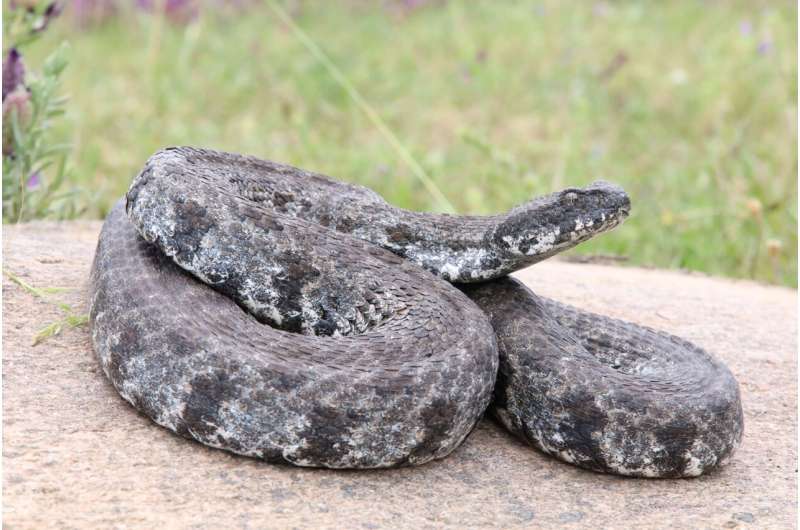This article has been reviewed according to Science X's editorial process and policies. Editors have highlighted the following attributes while ensuring the content's credibility:
fact-checked
peer-reviewed publication
proofread
Researchers reveal the venomous secrets of European snakes

Not only in the tropics do snake bites lead to dangerous envenoming—bites from European venomous snakes can also cause severe physical damage. But their venom also contains active substances that could be used against bacterial pathogens in the future.
Scientists from the Fraunhofer Institute for Molecular Biology and Applied Ecology IME in Giessen and the Hessian LOEWE Center for Translational Biodiversity Genomics are investigating the venoms of European snakes and have recently decoded the venom cocktail of the Milos viper native to Greece. Their study was published in the journal Frontiers in Molecular Biosciences.
Cobras, mambas, or rattlesnakes—most people are certainly aware that such venomous snakes can pose a danger to life and limb. Worldwide, almost 3 million snakebites occur every year, causing about 100,000 deaths, especially in tropical regions. The World Health Organization therefore recently classified snakebite as a neglected tropical disease.
But there are also venomous snakes in Europe. Although their bites are often much less dangerous than those of their tropical relatives, some species can cause long-term damage and even death. Compared to the venom cocktails of tropical snakes, those of European animals are much less well studied.
Hessian scientists from the Fraunhofer Institute for Molecular Biology and Applied Ecology IME and the Justus Liebig University Giessen are therefore working on research projects within the framework of the LOEWE Center for Translational Biodiversity Genomics on the neglected venoms of adders. The scientists have now succeeded for the first time in decoding the venom composition of the notorious Milos viper (Macrovipera schweizeri).
"The Milos viper is a close relative of the Levantine viper, one of the most dangerous venomous snakes in Europe and the Middle East. It lives only on a few islands in the Greek Cyclades, especially on Milos," says Dr. Tim Lüddecke, head of the Animal Venomics junior research group at Fraunhofer IME and research leader of the project. "Despite their close relationship to these dangerous animals and their unique ecological niche in the Cyclades, the venom of the Milos viper was completely unknown to us.
"By applying state-of-the-art mass spectrometry, so-called proteomics, we were able to identify the components in the venom of the Milos viper for the first time. We can show that its venom cocktail is almost identical to the venoms of the various subspecies of the Levantine viper and must conclude that it has comparable potency," says Lüddecke.
"To test our hypotheses, we determined the effects of the Milos viper venom experimentally in the laboratory. Thus, we measured its damaging effect on tissue using different cell types and the activity of protein-degrading enzymes and compared them with those of the Levantine viper. In fact, the effects of Milos viper and Levantine viper venoms are very similar," explains Lennart Schulte, Ph.D. student in the research group and lead author of the study. "Milos vipers are not aggressive animals and only bite humans to defend themselves. However, we have to assume that they are capable of causing medical emergencies."
Although the study confirms that Milos vipers are not harmless, their venom may have biomedical applications in the future. "We have identified several toxins that belong to protein classes with known efficacy against bacterial pathogens. These can possibly be used to develop new lead molecules for drug development against infectious diseases," explains Lüddecke.
"We have conducted initial activity studies with the toxin and show that it does indeed have strong activity against some medically relevant bacteria. Now we need to isolate these components and develop them further." The first experiments to separate the venom of the Milos viper and close relatives into their components are currently being prepared.
The now published study underlines that there is still much to learn about snake venoms beyond the particularly dangerous, tropical species. "It is of enormous importance that we develop a better understanding of the venom composition, function and poisoning symptoms of European venomous snakes as well," Lüddecke says.
"We will now pursue this task with special focus, targeting in particular our species found in Germany. We also know very little about their venoms," Schulte adds.
More information: Lennart Schulte et al, Venomics of the milos viper (Macrovipera schweizeri) unveils patterns of venom composition and exochemistry across blunt-nosed viper venoms, Frontiers in Molecular Biosciences (2023). DOI: 10.3389/fmolb.2023.1254058
Journal information: Ecology
Provided by Senckenberg Gesellschaft für Naturforschung

















